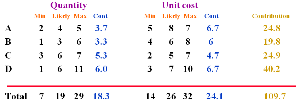Risk management - Multiple variables
Multiple variables
In some industries it is accepted that some WORK PACKAGES have a direct relationship to others in terms of their cost.
For example:
WORK PACKAGE A = 10 man weeks
It is known that work package B has a direct relationship with work package A. In fact, it always take twice as long to complete.
This is an example of ‘conditional correlation’ (at 100%) that we saw earlier.
So,
WORK PACKAGE B = 20 man weeks.
These relationships are quite common.
Another situation which may occur is when dealing with QUANTITIES of materials which do not have a fixed UNIT COST.
See the example below.
In this case, the exact quantities are unknown and are represented by a 3 point estimate.
Also, the unit cost is unknown and represented by a 3 point estimate.
The software will calculate a CONTRIBUTION for both the quantity and the Unit cost. The overall contribution is calculated by multiplying together the individual contributions.
Note: In this case, had we just multiplied together the totals of the likely values we would have got 19 x 26 = 494! A lot larger than 109.7. The latter reflects the weighting of the likely values within the ranges.



